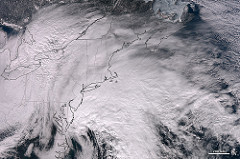
Credit: NASA/GSFC/Jeff Schmaltz/MODIS Land Rapid Response Team
Are you a mom who needs to pump and uses an electric pump?
- Consider getting a car adapter and/or a battery pack for your electric pump. Some electric pumps can also be converted to manual use – learn how to do this ahead of time.
- Consider getting a hand pump to use as your back-up pump.
- Learn how to hand express your milk.
Preventing your expressed milk from thawing
The first order of business is to try and prevent the milk from completely thawing. If there are still ice crystals in the milk, then it is still considered frozen– it is safe to either use the milk or return it to a working freezer.
Some ways to keep your milk frozen:
- If you have access to a generator, use it to operate your freezer during a power outage.
- If a neighbor or a nearby store has power, ask if you can store your milk in their freezer until power is restored. Make sure your milk has contact information on it!
- In your freezer (with no power): Open the freezer as little as possible. Food will stay frozen longer if the freezer is full: if you know ahead of time that you may lose power, fill empty spaces in your freezer with containers of water so that there is extra ice instead of empty space. Keep your expressed milk in the middle of the freezer, away from freezer walls. According to the USDA, “a full freezer will hold the temperature for approximately 48 hours (24 hours if it is half full) if the door remains closed.”
- In a cooler: Pack the cooler as full as possible, to slow thawing. Crumpled newspaper is a good insulator if there is extra air space in the cooler. Covering the cooler with blankets will also help to keep it cold.
- Extra air space in your freezer or cooler can be filled with dry ice, Techni Ice, “blue ice,” containers of water or ice, or snow.
- Are you in an area with snow on the ground? You may be able to store your milk in a snow bank, out of the sun, or use snow/ice to keep your milk cool in your freezer or cooler.
What if the milk has completely thawed?
Current guidelines recommend that this milk be used within 24-48 hours (24 hours if baby is a preemie or has immune issues that require stricter precautions) and not refrozen.
Now infants can get
all their vitamin D
from their mothers’ milk;
no drops needed with
our sponsor's
TheraNatal Lactation Complete
by THERALOGIX. Use PRC code “KELLY” for a special discount!
According to the Academy of Breastfeeding Medicine’s 2010 “Clinical Protocol #8: Human Milk Storage Information for Home Use for Full-Term Infants:”
There is little information on refreezing of thawed human milk. Bacterial growth and loss of antibacterial activity in thawed milk will vary depending on the technique of milk thawing, duration of the thaw, and the amount of bacteria in the milk at the time of expression. At this time no recommendations can be made on the refreezing of thawed human milk.
However, there is some information on refreezing human milk. A 2006 study looked at the effects of refreezing previously frozen milk (Rechtman, Lee, & Berg, 2006). The researchers used donor milk that had been expressed by mothers without following any special sanitary guidelines. The frozen milk was thawed overnight at refrigerator temperature, separated into batches, then refrozen in separate batches and thawed for a second time to room temperature. At this point, different batches were (1) kept at 46°F/8°C for 8 or 24 hours; (2) kept at 73°F/23°C for 4 or 8 hours; (3) exposed to multiple freeze-thaw cycles of various lengths; and (control) kept at -4°F/-20°C. Vitamin content was adequate for all the refrozen samples, and none of the sample batches that had been refrozen had unsafe levels of bacteria.
From the conclusion to this study:
The data generated by the authors support the contention that milk is relatively robust. Milk that has been left unrefrigerated for less than 8 hours, or placed in the refrigerator for a day, is safe to use and retains a good portion of its nutritional value. Moreover, it appears that unpasteurized milk that has been accidentally thawed remains safe to use provided it has not been left too long in an unthawed condition. Based on these data, it appears that unpasteurized milk that has thawed in the refrigerator for up to 8 hours may be safely refrozen. Moreover, this data would seem to support the use of frozen milk to which fresh milk has been added and then refrozen. This should allow for more convenient storage and for the salvage of milk that mothers might otherwise have been told to discard.
Rechtman DJ, Lee ML, Berg H. Effect of environmental conditions on unpasteurized donor human milk. Breastfeed Med. 2006 Spring;1(1):24-6. Also available here. Commentary here: Study results about frozen breastmilk. Also discussed in Breastfeeding Answers Made Simple (Mohrbacher, 2010, p. 461-2).
Additional resources:
- Weathering a storm with a freezer stash of breastmilk by Katy Linda, IBCLC
- Using Dry Ice Safely when Traveling with Breastmilk from the Children’s Hospital of Philadelphia
- Keeping Food Safe During an Emergency from the US Department of Agriculture
- Frozen Food and Power Outages: When to Save and When to Throw Out from FoodSafety.gov
- Keep Food and Water Safe after a Natural Disaster or Power Outage from the US Centers for Disease Control
- Storing Human Milk from La Leche League International

